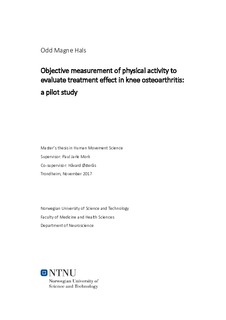| dc.description.abstract | Background and aim: Knee osteoarthritis (OA) is a chronic disease characterized by pain and loss of function. People with knee OA are less active than their peers, although regular physical activity (PA) is associated with improved physical function for those with knee OA. Physical therapy has proven beneficial for pain and function for those with knee OA. Several studies have shown that Medical Exercise Therapy (MExT) has positive effects for various knee conditions. Current outcome measures for people with knee OA include tests for physical function and questionnaires. These outcome measures have limitations in terms of transferability to daily functioning. Accelerometry have proven to be a preferred method for objective measurements of habitual PA, and have the potential to measure daily functioning. The aim of this study was to investigate whether objective measurements of PA can be used
to evaluate treatment effect of MExT in patients with knee OA.
Methods: Six patients between 60 and 77 years (mean age 67.5 years) diagnosed with knee OA volunteered to participate in the study. The intervention consisted of twelve weeks of MExT, three sessions per week. Pre- and post-intervention, habitual PA was recorded by two AX3 three-axis accelerometers over a seven-day period. In addition, the Knee Injury and Osteoarthritis Outcome Score (KOOS) and the Tampa Scale for Kinesiophobia (TSK) questionnaires were completed pre- and post-intervention.
Results: There were no significant changes in PA or the TSK questionnaire pre- to postintervention. The KOOS subscale Activity of Daily Living showed an increase pre- to posttest (p 0.006). Delta values of objectively measured PA was converging with delta values of the KOOS ADL subscale. Conclusion: This pilot study indicates that objective measurements of PA can be used to evaluate treatment effect of MExT in patients with knee OA. There were no missing data from the accelerometer recordings, and participant’s compliance to the exercise regimen and accelerometer recordings were high. There was no change in PA or the TSK questionnaire pre- to post-test. The KOOS ADL subscale showed an improvement from pre- to post-test, and converging delta values with objectively measured PA, thus indicating a potential association. Further studies should investigate whether there is an association between changes in objective measured PA level and the KOOS questionnaire. | nb_NO |
